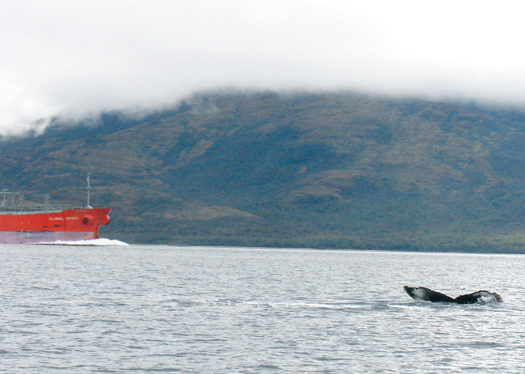
Whales in the Strait of Magellan. (Photos by Juan Capella, Whalesound)
Héctor Guzmán was mainly interested in studying the movements of humpback whales in the Strait of Magellan, a popular feeding ground of theirs, when he began tagging them with satellite transmitters over a decade ago. A marine biologist for the Smithsonian Tropical Research Institute in Panama City, he hoped to learn about population sizes and migration patterns of the humpback (Megaptera novaeangliae).
One day in 2016, while he was in Panama, he noticed that the transmitter of one of the South American whales was sending a signal continually from the same location, indicating that the whale it was attached to was stationary. After a week of no recorded movements, he contacted his Chilean colleagues, who piloted a boat to the location and found the whale had died and had a broken jaw. The scientists studied records of ship traffic and concluded that a large vessel had struck and killed the whale.
Last year, Guzmán decided to expand the study to sei whales (Balaenoptera borealis) in the strait. Then in March of this year, one of three sei whales he had tagged less than 10 days earlier washed up near Punta Arenas, Chile, the victim of another ship strike.
“I said, ‘Wow, this is really bad luck,’ ” Guzmán says. “The research began to shift. We started to look at ship data and could tell which of about two or three specific ships it was.”
Strait attracts attention
The strikes point to a growing problem in the Strait of Magellan, one now receiving more attention from researchers. In the last decade, at least five humpback whales and three sei whales were killed in the strait, likely due to ship strikes, according to a paper published in April by Guzmán and his colleagues. All the deaths occurred near Chile’s Isla Carlos III, waters in the western portion of the strait where whales typically feed from November through April. Four other living whales also show signs of ship strikes, with scars and partially mutilated tail fins.
While the strait’s whale population has grown over the past 10 years due partly to conservation efforts, “even an occasional ship strike could have important consequences,” says the recent paper he co-authored. “How is it possible I have tagged 30 whales in the Magellan Strait and two have been run over,” Guzmán says. “That means a large number of whales have been hit and no one reports them because it’s hard to find out about them unless you have the bad luck that I do.”
It is difficult to determine with certainty how many whale strikes occur in the strait each year, but the International Whaling Commission says such collisions—wherever they occur—could mean the difference between extinction and survival for certain species. The commission is developing a strategic plan to reduce ship strikes worldwide, a blueprint that will identify high-risk areas, expand reporting of collisions and recommend avoidance measures, including speed limits.
Guzmán calculates that an average of 2,023 ships a year travel the Magellan Strait. Assuming a population of 93 whales (the median of the 86 to 100 estimated to inhabit the water body on a seasonal basis), he and his colleagues determined in their April paper that there are 650 occasions during the year in which whales are within one kilometer (0.6 miles) of a ship.
Ship transits through the 350-mile (560-km) waterway have climbed over the past decade, reaching 2,773 in 2018—the greatest volume in at least two decades, according to Chile’s General Directorate for Maritime Territory and Merchant Marine, a branch of the Navy. The volume fell slightly to 2,406 last year, the second highest level since 2000.
Seeking political support
Guzmán has recommend limiting the speed of ships larger than 200 tons to 10 knots near the Isla Carlos III between the months December to April when whales are in abundance and feeding in the area. The limit would apply to a stretch of about 28 nautical miles on the Pacific end of the strait, from Isla Bonete to Cabo Holland. He has met with local companies and Chilean Senator Carolina Goic, whose home region of Magallanes brackets the strait. Goic has expressed support for the idea, though legislation embodying the proposal has yet to be drafted, Guzmán says.
Shipping-speed reductions elsewhere in the Americas have been applied to protect marine life in recent years. In the Gulf of Panama, traffic separation schemes and an August-through-November speed limit of 10 knots recommended by the International Maritime Organization are credited with helping to reduce ship collisions with migratory whales.
In certain areas of the U.S. east coast, vessels 65 feet or longer must not exceed 10 knots during specified times of the year to protect the endangered North Atlantic right whale, according to federal fisheries officials. A 2014 analysis by Julie van der Hoop, a biological oceanographer at Woods Hole Oceanographic Institution in Massachusetts, found that right whale deaths fell significantly in areas with seasonal speed limits, from two annually in 2000–06 to roughly 0.33 per year in 2007–12.
- Michael McDonald